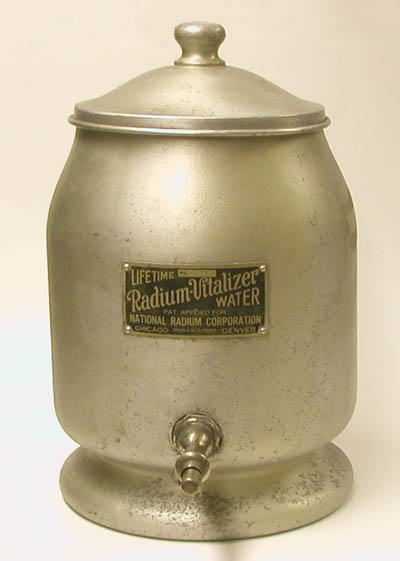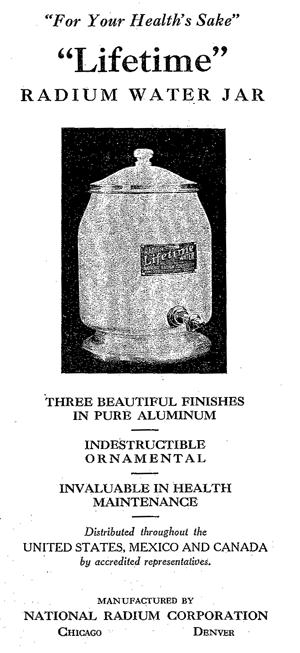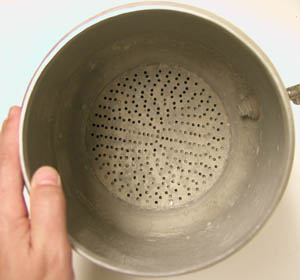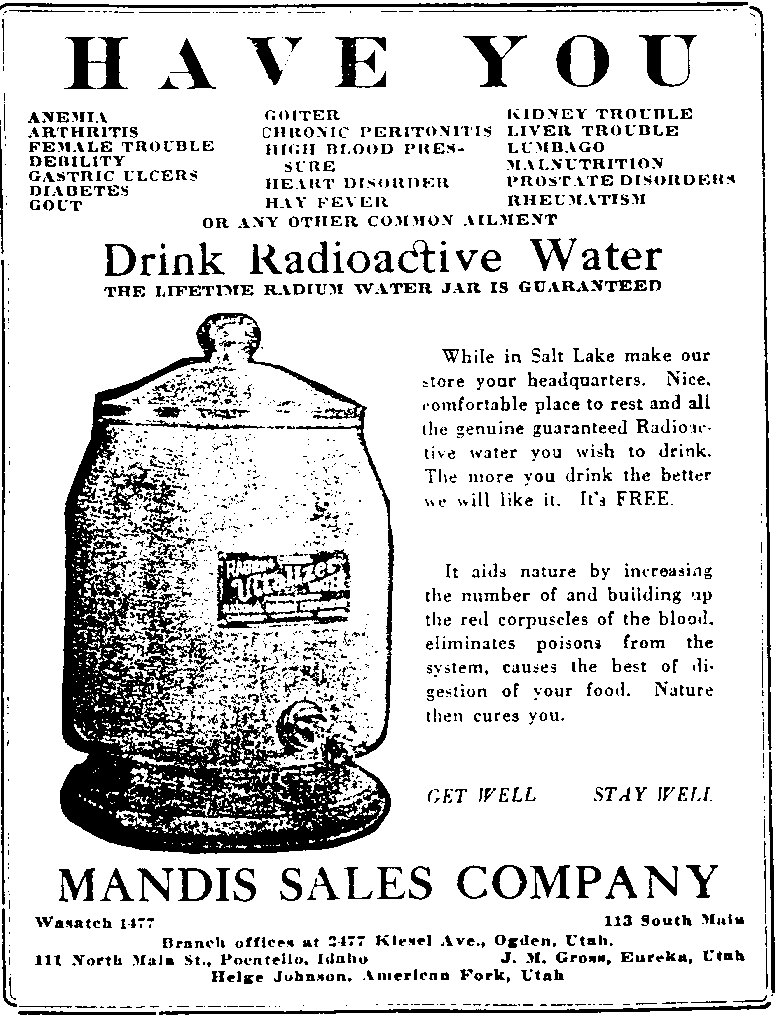Lifetime Radium-Vitalizer Water Jar (ca. 1925-1927)


The Lifetime Radium Vitalizer water jar was produced by the National Radium Corporation (1925-1927) in a probable attempt to replicate the success of the Revigator. Like the later, it was used to add radon (radium emanation) to drinking water.
The photo above right shows the cover of a company brochure for the "Radium Lifetime Water" jar.
Unlike the Revigator, the body of which was ceramic, the Lifetime Radium Vitalizer came in “THREE BEAUTIFUL FINISHES IN PURE ALUMINUM” “INDESTRUCTABLE” and “ORNAMENTAL”
A loose granular material covered with a perforated plate in the bottom of the jar served as the source of radon (see photo below). This material was described by a 1988 article in Health Physics as 100-200 grams of uranium ore. However, the manufacturer's literature refers to it as "a chemically prepared radium salt in the form of insoluble Radium barium sulfate. The amount is measured and guaranteed free from any mineral poisons such as are found in carnotite ore, arsenic, uranium, vanadium, etc."

The company promised that this source would
“At equilibrium time, delivers 400 millimicrocurics Ra. Emanation [radon] per liter of water on average gallon content.”
Size: ca. 14" high, 9" diameter
Exposure rate: ca. 40 uR/hr at one foot from base
Donated by Ed Landa.
The image to the right shows the cover of a company brochure for the "Radium Lifetime Water jar.
The Names of the Jar
The jar’s original name, Lifetime Radium Vitalizer Water Jar, was possibly inspired by that of another Denver business, the Vital-O-Remedies Company (aka Vital-O-Gland Company). A later incarnation of the latter, the Home Products Company, produced the Vita Radium Suppositories featured in the ORAU collection.
The name seems to have been considered a mistake, and it was changed from the "Lifetime Radium-Vitalizer Water Jar” to the "Radium Lifetime Water Jar.” A brochure for the "Radium Lifetime Water Jar” (image to right) contained testimonial letters from October and November of 1925. Although one letter referred to the “Vitalizer” jar, most of them specifically mentioned the “Lifetime Radium Water Jar.” This suggests that the change of names occurred in 1925.
There is a bit of irony here—the company’s lifetime was pretty brief—two to three years, at most.
The National Radium Corporation was the creation of its president, William Bryan. Information about him can be found in the description of the collection’s Radium Bath Salts.
The 1926 Denver City Directory indicated that C. M. Smith was a manager at the National Radium Corporation, but I have no other information concerning him.
The earliest reference I have to the company and/or the Lifetime Radium Vitalizer jar is from April 1926. Nevertheless, because the company literature includes testimonial letters from October and November of 1925, I suspect that the company began operations that year, i.e., 1925.
While the National Radium Corporation headquarters was in Denver, they also operated out of Chicago, most likely as the Radium Products Corporation. It’s probably not a coincidence that another Denver company run by William Bryan had a similar name, the Radium Products Laboratories.
The company’s demise came about in 1927 when William Bryan was killed beneath an overturned vehicle. One leg was cut off and his neck was broken. If the National Radium Corporation limped along after that, it wasn’t for very long.
National Radium Corporation Addresses
208 Pythian Building, Denver, Colorado (office)
2301 15th Street, Denver, Colorado (plant)
That William Bryan was a 32nd degree Mason and a member of the Knights of Pythias helps explain why his National Radium Corporation occupied an office on the second floor of the Pythian Building, a masonic lodge.
The company’s other Denver address, 2301 15th Street, was where the ore processing took place. It later became famous as an EPA Superfund site. Quoting the EPA report “Superfund Record of Decision: Denver Radium/Open Space CO” (EPA/ROD/R08-87/014. 1987):
“The property included a building at 2301 15th Street that was occupied by the National Radium Corporation in 1926 and 1927. The building was believed to be the ore lab.” “The radium-contaminated soil present on the CSRR property is apparently the result of a radium, vanadium, and uranium processing operation conducted by the National Radium Corporation.”
Radium Products Corporation was, I believe, the name used by the Chicago branch of the National Radium Corporation. My guess is that the Lifetime Radium Vitalizer jar was manufactured in Chicago, while the jar’s radioactive material was produced in Denver.
The individual running the Chicago branch of the company was probably Hugh Armstrong. Information about him can be found in the description of the collection’s Radium Vitalizer Health Fount.
Address: 30 N. La Salle St., Chicago, Illinois
Since the Lifetime Radium Vitalizer jar was the only item produced by the National Radium Corporation, their marketing strategy was pretty simple. Rather than operate retail outlets, they sold the jars via sales agents.
Locating these sales agents was the purpose of a pair of classified ads in the April 1, 1926 issue of the Logansport Pharos Tribune. The ads are the earliest references I’ve found to the jar.
LOCAL AGENTS—To sell Lifetime Radium Vitalizer, full or part time. Exceptional commission arrangement, product guaranteed, everyone a prospect. Radium Products Corporation 30 N. La Salle St., Chicago.
DISTRIBUTORS—To sell Lifetime Radium Vitalizer through agents. Exclusive contract, product guaranteed. Leads and sales assistance. No competition, exceptional proposition to qualified distributors. Radium Products Corporation 30 N. La Salle St., Chicago.
It’s not clear how successful they were at locating sales agents, but they found a few, e.g.:
Florida Vitalizer Sales Agency, 38 South Main Street, Orlando, Florida
Radium Vitalizer Sales Agency of Pennsylvania, 310-311 Savings Bank Building, Butler, Pennsylvania
Mandis Sales Company/G&H Company, 113 South Main Street, Salt Lake City, Utah
The Mandis Sales Company and the G&H Company (both had the same address at 113 South Main, but at different times) were the most prolific advertisers of the jar.
Every month, beginning with its June 1926 issue, the Relief Society Magazine included a three quarter page advertisement for the Lifetime Radium Water Jar. The ads were placed by the G&H Company from June through September 1926, and by the Mandis Sales Company from October 1926 through May 1927. The last appeared the same month that William Bryan was killed.
Let’s close this discussion about the National Radium Corporation with a quote from the July 1926 G&H ad:
“The National Radium Corporation of Chicago and Denver, the oldest and largest Radium concern in the world has perfected the Lifetime Radium Water Jar, guaranteed for a lifetime [the company went out of business in 10 months] to produce a greater amount of Radioactivity than is found in any World Known Health Spring.”
Not quite truthful, but what can you expect, it was written by people in sales.
The following quotes regarding William Bryan are from the "American Biography: A New Cyclopedia" (Vol. 36, p. 125. 1928). Note that this was an uncritical retelling of information submitted by Sally Bryan in honor of her late husband.
“This generation and the generations of men that are to come will revere the memory and honor the name of William Edgar Bryan, who discovered the method of converting radium into soluble form”
How to produce soluble compounds of radium was never a problem. Soluble forms of radium for drinking were sold by the Standard Chemical Company (Radium Chemical Company) as early as 1914. To be charitable, Bryan had no formal training in chemistry and he would have had to “discover” this for himself. I suppose.
“he became proficient as an illustrator and designer, and headed several art departments of some of the largest printing establishments in the western part of the United States... eventually his love for the study of chemistry caused him to forsake art and enter the laboratory to do his life's work. About 1915, he started to work in the United States Government radium plant in Denver.”
The U. S. government plant mentioned here could only refer to the National Radium Institute (NRI) facility. To my knowledge, he only “worked” in the plant after it had been sold by the NRI to Bryan’s Minerals Recovery Company.
“Later he took up chemical research work, and, with Mrs. Bryan's assistance, established a research and distributing laboratory in that city.”
The research and distributing laboratory being referred to would be the Radium Products Laboratories, later known as the Denver Radium Service Laboratories.
In May of 1927, only two hours after he had been released on bond for a charge of speeding inside city limits, William Bryan was killed when his vehicle overturned on the Lincoln Highway near Helena, Montana. He was pinned underneath. One leg was cut off and his neck was broken.
The newspaper accounts only indicated that Bryan had some sort of relationship with the Denver Radium Service (Helena Independent, May 4, 1927). As likely as not, Denver Radium Service products and/or literature were found in the wrecked vehicle.
The following sections provide a chronological account of William Bryan’s career until 1925 when he organized the National Radium Corporation and began producing the Lifetime Radium Vitalizer water jar.
William Bryan, Harry Bryan and the Universal Manufacturing and Sales Company (1916)
From 1914 to 1920 or so, William Bryan made a remarkable transition from artist to business man. I suspect that this happened, in large part, because of his father Harry S. Bryan. The latter, who liked to be called Major Bryan, was the “President and manager of the Compania Mexicana de Impermeables of the City of Mexico” in 1913 when Mexican President Madero was killed in a coup. Much to Bryan’s displeasure, the US government issued an American evacuation, something that put his business interests (presumably to the tune of $150,000) in jeopardy. Not one to remain quiet, his complaints about President Woodrow Wilson and the government’s response received front page coverage in the New York Time (Sept. 27, 1913). In subsequent press accounts Harry continued to voice assurances that Americans in Mexico were safe, and noted that he was perfectly comfortable knowing that his son (William) was in Mexico City (Evening Independent May 1, 1914).
Probably in 1915, but certainly by 1916, Harry had given up on Mexico and moved to Denver where he and William became involved with the Universal Manufacturing and Sales Company. This business, licensed in 1916, seem to have been the controlling company for several small firms in the mining and milling field. They sold, or tried to sell, at least one product: the Universal Dry Concentrator. The latter was a device for separating out the components of raw ore that contained the minerals of interest (e.g., vanadium).
The last reference I have found to the company was a newspaper ad placed by William Bryan announcing an upcoming stockholders meeting at which the next board of directors would be selected (The Mining American. Sept. 2, 1916).
The Universal Manufacturing and Sales Company office was located at 1734 Glenarm Street, Denver, Colorado.
William Bryan, Harry Bryan and the Minerals Recovery Company (1917-1920)
In 1917, the Universal Manufacturing and Sales Company was history, and the Bryans were devoting their energy to running the Minerals Recovery Company.
Conveniently for everybody involved, the Minerals Recovery Company took over the old office of the Universal Manufacturing and Sales Company at 1734 Glenarm Place (as well as the office next door at 1732 Glenarm).
The company’s incorporation papers identified Dr. P. H. Chambers (William’s father-in-law) as president, William E. Bryan as secretary and manager, and Ralph R. Knowles as the company metallurgist. Later, W. W. Anderson (a bookkeeper I believe) would be identified as the vice-president. As described in its incorporation papers, the operation consisted of a radium extraction plant, crusher, rolls and 3 ball mills as well as a 15-ton concentration plant. $250,000 in stock was issued at $1.00 per share (American Mining & Metallurgical Manual, 1919).
The ore processing facility was a real functional plant that they purchased from the National Radium Institute. It was located at 457 South Elati Street in Denver.
The plan was to extract radium, as well as vanadium and uranium when economical (Mining and Scientific Press. Vol 118. 1919). That was the plan, but to my knowledge ore was never processed by the Minerals Recovery Company. Now this could be chalked up to bad management—after all, the company’s president was a dentist and its secretary was an artist. On the other hand, there is the possibility that the company’s management never intended to process anything.
What they did do was sell stock and market something called the Bryan Process (Mining Congress Journal. Vol. 5 No. 8. Aug. 1919).

The following is a 1926 advertisement from the Mandis Sales Company.
They did something else, they sold their ore processing equipment. And that is where Major Harry S. Bryan came in. Within a year of the company’s incorporation, Harry, the company’s “general manager,” seems to have been selling its equipment to the United States Vanadium Development Company (Arizona Republican. April 22, 1917). The last information I have concerning this sale is from a story in the January 5, 1918 issue of the Arizona Republican. The article indicated that the Vanadium Development Company’s mill was almost complete, and that Harry Bryan was arranging the transfer of the last few mill parts from Denver. Vanadium Development Company stockholders could rest easy.
The Minerals Recovery Company went out of business in 1920 “after having serious legal troubles” (Radium Production. The Mineral Industry in 1920. Vol. 29. 1921).
William Bryan and the Radium Products Laboratories (1922-1925)
In 1920 and 1921, the two years following the collapse of the Minerals Recovery Company, William Bryan was described in the Denver City Directory and the Colorado Business Directory as being involved in the production of radium, uranium and vanadium and “products.” No company affiliation was indicated.
The Radium Products Laboratories Inc. made its first appearance in the 1922 Denver City and Colorado Business Directories with William Bryan identified as the company president. Warren R. McLaughlin was also indicated by the directory as being associated with the company. McLaughlin described himself in the 1920 census as a promoter in the stocks and bonds industry, and as a chemist in the pharmaceutical industry in the 1930 census. Just the kind of multidisciplinary talent Bryan would appreciate. Subsequent directories usually described the company’s business as “radium and radium products,” but the 1925 Colorado Business Directory also mentioned “cosmetics.”
For the years 1922 and 1923, the company was located where you would expect, 1732-1734 Glenarm Place, but I found two different addresses for them in 1924: 1405 Glenarm Place and rooms 205-208 in the Pythian Building.
The Radium Service and the National Radium Corporation
The Radium Products Laboratories seems to have split into the Denver Radium Service Laboratories and the National Radium Corporation sometime in 1925. All three companies, at least for a period of time, occupied the second floor of the Pythian Building.
The National Radium Corporation is discussed in detail towards the top of this page. If you want more information about the Denver Radium Service Laboratories, it can be found in the description of the collection’s Radium Bath Salts.
Timeline for William Edgar Bryan
| Date | Activity |
|---|---|
| 1884 | William Bryan was born in Zanesville, Ohio |
| 1910 | He was identified in the 1910 census as an artist; William Bryan and Sally Chambers were married |
| 1916 | He was the secretary of the Universal Manufacturing and Sales Company (Denver CityDirectory) |
| 1917 | Bryan was the secretary of Minerals Recovery Company (Denver City Directory) |
| 1919 | He was the manager of the Minerals Recovery Company as well as the company’s secretary (Denver City Directory) |
| 1920 | Bryan was involved with vanadium production (Denver City Directory) but the 1920 census indicated his occupation as “artist” |
| 1921 | Bryan was a producer of radium, uranium and vanadium ores and products (Denver City Directory) |
| 1922-1925 | He was president of the Radium Products Laboratories, Inc. (Denver City Directory) |
| 1925 | He was associated with the Denver Radium Service (Denver City Directory) |
| 1926-1927 | He was president of the National Radium Corporation |
| 1927 | William Bryan was killed in a car accident |
References
- Landa, E., Miller, C., Brich, R. Radioactive and Non-radioactive Solutes in Drinking Water from Rn-Charging Devices. Health Physics.54 (1): 99-106; 1988.
- Product Literature. No date.
